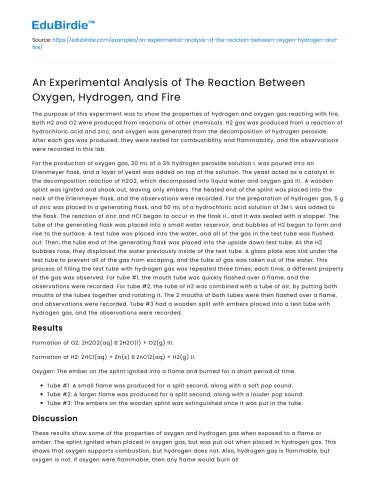The purpose of this experiment was to show the properties of hydrogen and oxygen gas reacting with fire. Both H2 and O2 were produced from reactions of other chemicals. H2 gas was produced from a reaction of hydrochloric acid and zinc, and oxygen was generated from the decomposition of hydrogen peroxide. After each gas was produced, they were tested for combustibility and flammability, and the observations were recorded in this lab.
For the production of oxygen gas, 30 mL of a 3% hydrogen peroxide solution I. was poured into an Erlenmeyer flask, and a layer of yeast was added on top of the solution. The yeast acted as a catalyst in the decomposition reaction of H2O2, which decomposed into liquid water and oxygen gas III.. A wooden splint was ignited and shook out, leaving only embers. The heated end of the splint was placed into the neck of the Erlenmeyer flask, and the observations were recorded. For the preparation of hydrogen gas, 5 g of zinc was placed in a generating flask, and 50 mL of a hydrochloric acid solution of 3M I. was added to the flask. The reaction of zinc and HCl began to occur in the flask II., and it was sealed with a stopper. The tube of the generating flask was placed into a small water reservoir, and bubbles of H2 began to form and rise to the surface. A test tube was placed into the water, and all of the gas in the test tube was flushed out. Then, the tube end of the generating flask was placed into the upside down test tube. As the H2 bubbles rose, they displaced the water previously inside of the test tube. A glass plate was slid under the test tube to prevent all of the gas from escaping, and the tube of gas was taken out of the water. This process of filling the test tube with hydrogen gas was repeated three times; each time, a different property of the gas was observed. For tube #1, the mouth tube was quickly flashed over a flame, and the observations were recorded. For tube #2, the tube of H2 was combined with a tube of air, by putting both mouths of the tubes together and rotating it. The 2 mouths of both tubes were then flashed over a flame, and observations were recorded. Tube #3 had a wooden split with embers placed into a test tube with hydrogen gas, and the observations were recorded.
Save your time!
We can take care of your essay
- Proper editing and formatting
- Free revision, title page, and bibliography
- Flexible prices and money-back guarantee
Results
Formation of O2: 2H2O2(aq) → 2H2O(l) + O2(g) III.
Formation of H2: 2HCl(aq) + Zn(s) → ZnCl2(aq) + H2(g) II.
Oxygen: The ember on the splint ignited into a flame and burned for a short period of time.
- Tube #1: A small flame was produced for a split second, along with a soft pop sound.
- Tube #2: A larger flame was produced for a split second, along with a louder pop sound.
- Tube #3: The embers on the wooden splint was extinguished once it was put in the tube.
Discussion
These results show some of the properties of oxygen and hydrogen gas when exposed to a flame or ember. The splint ignited when placed in oxygen gas, but was put out when placed in hydrogen gas. This shows that oxygen supports combustion, but hydrogen does not. Also, hydrogen gas is flammable, but oxygen is not. If oxygen were flammable, then any flame would burn all of the O2 in the air. The hydrogen mixed with air produced a stronger reaction that just H2 itself because the flame from the hydrogen gas allowed the oxygen in the air to combust. Possible sources of error could have been leaks of gas from the test tubes.
Conclusion
This experiment was effective and accurately demonstrated the properties of H2 and O2 reacting with flames or embers. Since there was no quantitative data in this experiment, there is not percent error, but the results matched the expected results. This experiment showed that there is a difference between combustibility and flammability, two terms that could’ve perhaps been used interchangeably






 Stuck on your essay?
Stuck on your essay?

